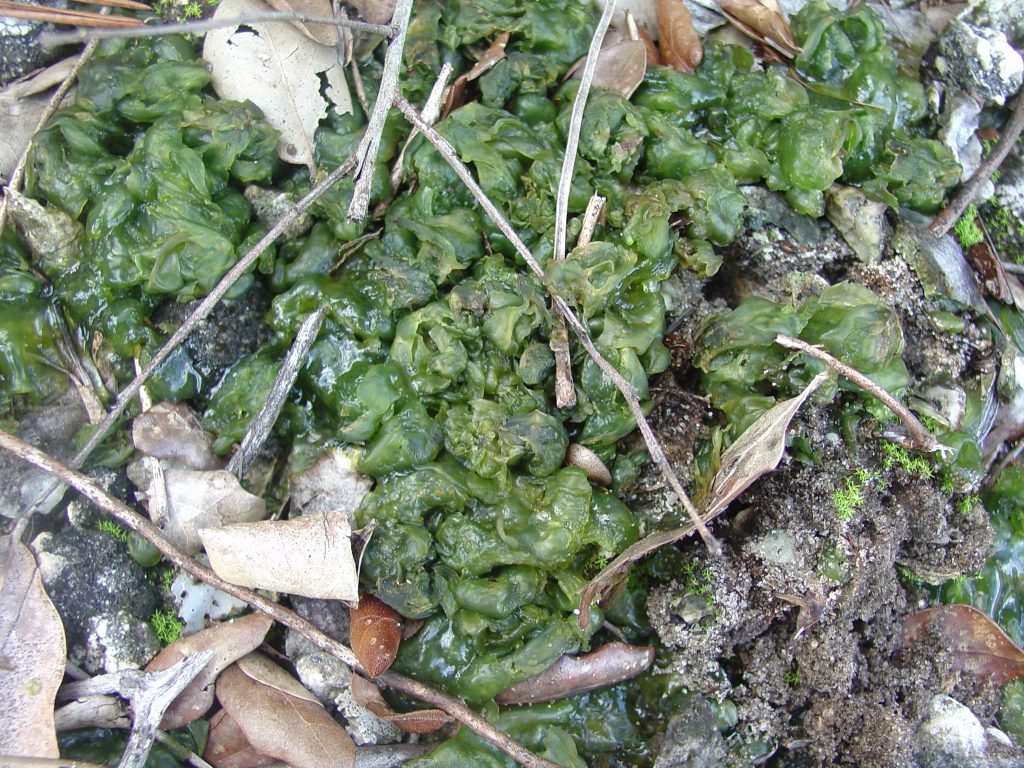
Nostoc… for when you are really hungry.

BC’s philosopher Wiley.
In the old cartoon series BC, Wiley, a peg-legged curmudgeon, was the strip’s philosopher. One day he opined: “The bravest man I ever saw was the first one who ate an oyster raw.” He could have easily penned “who ate nostoc raw.”
Nostoc can resemble a pile of disintegrating dog scat. Not exactly appetizing. If you add that there are some 300 hard-to-identify species Nustoc barely creeps into the realm of edible. As one might presume in parts of the world where there are billions to feed they eat it… and other places, too. Perhaps the easiest stop to find locally it is on the ground cover one walks on in nurseries. Apparently it is the cause of much slipping and falls. In the wild I see it now and then in high and dry ground with much water nearby and moisture in the air. It is particularly common near Haul Over Canal on the northwest scrubby side.
Nostoc was a mystery for centuries as folks thought it was alien and was seen after a variety of celestial events. We now know it is an algae plumped up by passing rain. Some flies like to lay eggs in it, apparently with bad effects. An article in the 2008 Journal of Ethnopharmacology reported in the Peruvian highlands Nostoc commune when eaten as food can produce the neurotoxic amino acid BMMA. From the Abstract:
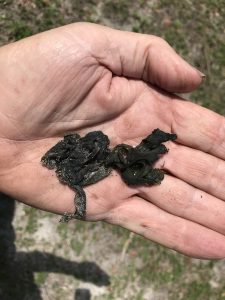
Is Nostoc a no-no? Photo by Green Deane
“In the mountains of Peru, globular colonies of Nostoc commune (Nostocales) are collected in the highland lakes by the indigenous people, who call them llullucha. They are consumed locally, traded for maize, or sold, eventually entering the folk markets of Cusco and other neighboring cities. Throughout highland Peru, Nostoc commune is highly salient as a seasonal dietary item, being eaten alone, or in picante — a local stew — and is said to be highly nutritious. Nostoc commune has been known to produce unusual amino acids, including those of the mycosporine group, which possibly function to prevent UV damage. We analyzed 21 different Nostoc commune spherical colonies from 7 different market collections in the Cusco area for the presence of beta-N-methylamino-L-alanine (BMAA), a neurotoxic amino acid produced by diverse taxa of cyanobacteria, using four different analytical techniques (HPLC-FD, UPLC-UV, UPLC/MS, LC/MS/MS). We found using all four techniques that BMAA was present in the samples purchased in the Peruvian markets. Since BMAA has been putatively linked to neurodegenerative illness, it would be of interest to know if the occurrence of ALS, Alzheimer’s, or Parkinson’s Disease is greater among individuals who consume llullucha in Peru.” This was echoed in a Chinese study.
Some have argued this is also why you should also not eat Alfalfa or Black Medic because of BMAA. Other studies disagree, such as “Toxicity and bioaccumulation of two non-protein amino acids synthesised by cyanobacteria, β-N-Methylamino-L-alanine (BMAA) and 2,4-diaminobutyric acid (DAB), on a crop plant.” (Ecotoxicology and Environmental Safety, 15 January 2021.) All that said there is a general rule about algae and that is never eat blue-green algae. Green yes, blue-green never. A nitrogen fixer, you can read more about Nostoc here.
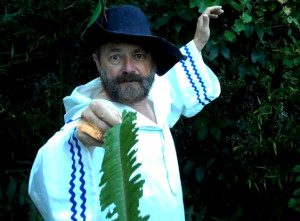
Engarde! From my Sword Fern video.
This is my 500th newsletter. Some quick math suggests that’s about a decade of correspondence but it’s actually 16 years worth. The first newsletters were monthly. Back then I had to do the mailing as well. It was quite a chore. If one email address was wrong — or the mail box full –the entire mailing was aborted and there was no hint which address triggered the rejectiion. Now the mailing costs $40 a month (if I keep editing out folks who subscribe but never read the newsletter.)
Topics covered in that first newsletter were: Water Vine, Smilax, Doesn’t Grow Here, Kudzu, Elderberry/Water Hemlock, Pomegranate Ponderings, the fact that elephants do not like chili and feeding cows curry reduces their methane production by 40%. The newsletter is published on Tuesdays because research 16 years ago said that was the day of the week an email was least likely to be deleted unread. It also gave me a one day break from teaching foraging classes on the weekend. I did not start the newsletter on a whim (or for advertising.)

Green Deane in his journalism days four decades ago. Photo by Wang Su-mei
Some 40 years ago I was working journalist on daily newspapers. I covered law and crime and wrote features on the side. I also freelanced for national magazines and later ended up as an assignment editor for a TV station. I left that job because that was the beginning of “making” news rather than reporting news… The TV reporters, we called them “twinkies,” were good-looking but more often than not empty headed and had to be told what questions to ask. Anyway, on one newspaper the reporters had to write a weekly column. It was actually the editor’s job to write one new column a day — a running feature, on the top of page three — but instead he farmed it out to seven writers. There were restrictions: It has to be about a local issue, it could not be an opinion piece, and had to be relevant to the coverage area. Those of us who had to write a weekly column came to loathe it. It was a re-occuring migraine and often one did not have anything to write about, and, unlike today, fiction and advocacy was not allowed.
So I knew the newsletter pitfalls when I started this endeavor. Fortunately there is always something to write about in the foraging world and the newsletter takes up only about one day per week, first word to mailing. I do not post newsletters on Facebook regularly because I deliberately chose not switch over to that medium. It’s too capricious and unreliable even if it would save some $500 a year. I also tend to end up in Facebook Jail regularly and always completely by surprise. The things that offend Facebook is ever-increasing.
And of course a newsletter is pointless without readers. Thank you for tolerating all these years of repetition, typos and misspellings. The mistake are all my own.
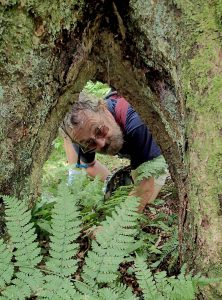
Possible Book Cover Photo
What of the book? Some seven years ago I proposed a book to some publishers: They collectively said no. Then one, in October 2020, said yes and could I deliver the book in 90 days to be printed in 2021? So I put my life on hold and wrote the book in 90 days turning it in on time (years of newspaper deadlines made that possible.) Then they said thanks but we won’t start it until 2022 and put it on sale in 2023. Bummer: Slow-forward: They are starting to put the book together. The good news is they are keeping most of the 430 articles I sent (covering more than 1500 species.) It is international in scope (European weeds went everywhere the Europeans went.) What makes this forth-coming book different, besides my endless ranting about dunk botanists and Dead Latin, is each entry — or almost every entry — includes nutritional information about the plant: Vitamins, minerals, anti-oxidants et cetera. That comprised most of the research as I already had the bulk of material written for my website. And yes there are color pictures, most of which I took over the years. The biggest headache, of all things, was vitamin A. It is expressed in a variety of ways that don’t easily translate into one metric. I finally gave up and kept all the various metrics. I might have preprints by October, three years after the project started. Actually this is my third book. My first one was in 1990 called 1001 Facts Somebody Screwed Up, followed by 1001 More Facts Somebody Screwed Up. Neither had 1001 facts. They did together way back at the beginning before editors got their delete buttons on it. Anyway, that publisher went out of business and sold the right to publish those book to cover debts. So one can still buy them but I have not seen a royalty check from them since 2000. And that, “dear readers” as Dear Abby use to write, is the publishing world. I dive had some short fiction published along the way most notably in Ellery Queen’s Mystery Magazine.
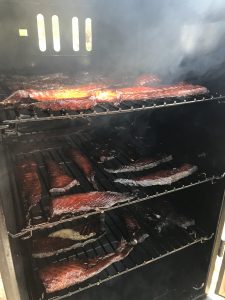
Smoking Salmon
Where I grew up the Alder was called a trash tree. Why? It took over freshwater wetlands and filled in ponds. Not a strong wood, long lived or large. Folks never mentioned it’s prime wood for smoking meat and other comestibles… such as cheese. Smoking can preserve and flavor.
Pairing the wood to the food to be smoked is perhaps more an art than a science, an exercise in personal taste. I am more inclined to use what I have on hand or tinker with it a little. I’ve been saving wood for particular applications. So far my stash includes maple, white oak, apple, mesquite, and avocado. Surprisingly citrus wood is difficult to come by.
Camphor gets a bad rap on the internet. I used to burn camphor in my fireplace. The Chinese make a famous duck dish using camphor smoke for flavoring. American barbecue pages all scream Camphor wood is toxic… however one commercial smoke house in northwest Florida uses camphor wood particularly on fish. And many sites warn cherry is toxic though you can buy cherrywood expressly for smoking particularly seafood. (I think perhaps they are confusing different species.) They also approve of a western juniper but condemn an eastern juniper and mistakenly call them cedars. All condemned the sycamore…. which is used for skewers and wooden spoons and bowels et cetera. They say Sycamore has a resin. Sycamore is quite close to the maple. I’m collecting sycamore sap now for syrup. Maple sap is clear, like water. Sycamore sap is — collectively — dark orange. Maybe it does have a resin… I will have to burn some and report.
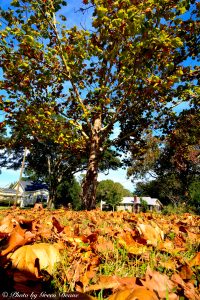
Sycamores is a hardwood not used for smoking.
Meats, seafoods, and cheese are foods that are regularly smoked. (I wonder if hard-boiled eggs can be smoked?) Delicate smoke for mild foods, stronger flavored for red meats et ali. Getting general approval for smoking is Acacia, Alder, Almond (I’d question that as I do Prunus caroliniana. Perhaps they mean Sweet Almond.) Apricot, Ash, Aspen (well aged, it can be sappy unless quite dry) Australian Pine (which is not a pine but closer to the oaks than conifers. The wood and dampened needles are used) Beech, Birch, Blackberry Roots, Bottlebrush Tree, Bunya Bunya cone leftovers, Butternut, Carob, Carrotwood, Chestnut, Coconut Husks (be careful, they have flaming gas jets, I know that from personal experience.) Corn Cobs, Cottonwood, Dogwood, Fig (sparingly) Grape Vine, Gorse, Guava, Heather, Hickory, Honey Locus, Jabuticaba, Jackfruit, Kiawe, Lead Tree (Leucaena leucocephala) Lilac, Lychee, Madrone, Magnolia (I presume M. virginiana which is also a good wood to grow oyster mushrooms on) Manzanita, Mulberry, Nectarine, Oak (white and red) Olive, Orange (the latter for pork, also grapefruit, lemon, lime) Osage Orange (blended with oak) Peach, Pear, Peat, Pecan, Persimmon, Pistachio Shells, Pimento, Plum, Red Mangrove (Rhizophora racemosa) Santol, Sassafras, Seaweed (washed) Starfruit, Straw, Sugarcane, Tamarind, Willow, and Walnut, Black and English.
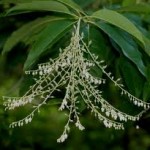
Sourwood is chewed but not eaten.
Some woods are in …limbo… like the Sycamore and Sweet Gum (all the gum trees taste bad.) Another one is sourwood. Natives cooked meat on sourwood sticks so it can’t be all that bad. No reports on Southern Wax Myrtle, some report Crape Myrtles can be used. If the Bradford Pear could be used to smoke food it would help eliminate that non-productive, invasive ornamental species. As it is related to the apple perhaps it can. I’ve also got three gallons of dried Queen Palm kernels I’m going to try. They have a coconut-flavored. I wonder how they would smoke and taste… explode perhaps? You don’t use conifers for smoking (such as true pines, firs, hatmatacks, cypress et cetera.) They throw a foul flavor.
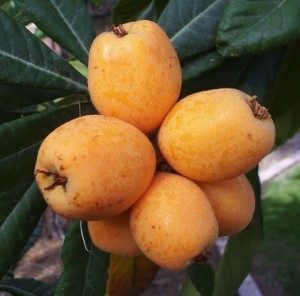
A loquats ripen the get sweeter. Photo by Green Deane
Perhaps the next two species do not need repeating but I’ll assume you are a new reader. Loquats are in full fruit now particularly in the middle of the state. In south Florida they will be around for two or three more weeks. In north Florida they are just beginning to ripen. They’re usually fruit for six to eight weeks in each location. Like Star fruit they start out green turn light yellow and tart then slowly turn deep golden and very sweet. Unlike green star fruit green loquats are NOT edible. In fact there is one report in the literature in which a green loquat killed a child. Don’t eat the green fruit. They also naturally have a small amount of arsenic, enough to trigger tests for said. You can read about loquats here and a video here.
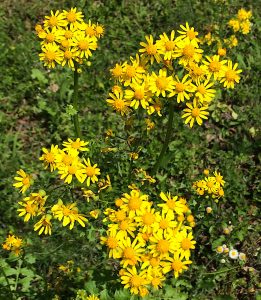
Butterweed’s blossom does not resemble a mustard. Photo by Green Deane
This. too, has been mentioned earlier but bears repeating: Butterweed is toxic. The warning is prudent because the plant — before it blossoms — resembles a generic mustard. However, unlike all mustards, Butterweed has a mild flavor whereas all mustards have at least some pungency. If you mistakenly eat Butterweed raw or cooked it will damage your liver. Once the plant blossoms it does not resemble any mustard as the flowers are quite different. Mustards have four-petaled blossoms, Butterweed’s blossom looks like a yellow daisy. The plant likes to grow in damp places and gets to be about a yard high when at the blossoming stage. Unfortunately the leaves have a nice texture and a mild taste. That tells you immediately that it is not a mustard.
Foraging Classes as the cold moderates and the chance of rain increases. This weekend I am in Ft Pierce, at a rather strange preserve, and this Sunday at a familiar standby, Mead Garden in Winter Park.
Saturday March 26th, George LeStrange Preserve, 4911 Ralls Road, Fort Pierce, FL, 34981. 9 a.m. to noon. This location does not have official bathrooms or water.
Sunday March 27th, Mead Garden: 1500 S. Denning Dr., Winter Park, FL 32789. Meet at the bathrooms. 9 a.m. to noon.
Saturday April 2nd, Dreher Park, West Palm Beach, 1200 Southern Blvd., West Palm Beach, 33405., 9 a.m. to noon. Meet just north of the science museum.
Saturday/Sunday May 7th & 8th, Honea Path, South Carolina, classes at 9 a.m. and 1 p.m. each day.
For more information, to pre-pay or sign up go here
My nine-DVD set of 135 videos has been phased out and replaced by 171-videos on a 128-GB USB, see left. The USB videos are the same videos I have on You Tube. Some people like to have their own copy especially if social order falters. The USB videos have to be copied to your computer to play. If you want to order the USB go to the DVD/USB order button on the top right of this page or click here. That will take you to an order form. Or you can make a $99 donation, which tells me it is for the USB (include a snail-mail address.) I’d like to thank all of you who ordered the DVD set over the years which required me to burn over 5,000 DVDs individually. I had to stop making them as few programs now will read the ISO files to copy them. Burning a set also took about three hours.

Green Deane Forum
Want to identify a plant? Perhaps you’re looking for a foraging reference? You might have a UFO, an Unidentified Flowering Object, you want identified. On the Green Deane Forum we — including Green Deane and others from around the world — chat about foraging all year. And it’s not just about warm-weather plants or just North American flora. Many nations share common weeds so there’s a lot to talk about. There’s also more than weeds. The reference section has information for foraging around the world. There are also articles on food preservation, and forgotten skills from making bows to fermenting food. Recent topics include: Stale Bread and Cod Liver Oil, Killing Bugs with Tobacco Plugs, Eating weeds: Is it safe? Have they mutated? Not the Eastern Red Bug but the Pink Tabebuia, African Tulip Tree, Asparagus densiflorus, Green Deane’s Book… You can join the forum by clicking on the button on the upper right hand side of this page.
This is my weekly newsletter #500. If you want to subscribe to this free newsletter you can find the sign-up form in the menu at the top of the page. My website, EatTheWeeds.com, which is data secure, has over 1500 plants on it in some 428 articles. I wrote every one myself, no cut and paste.
To donate to the Green Deane Newsletter click here.
— The hunt for a place to move to continues. Looking for a fixer upper on agicultural land preferably on the southern half of the state. Quiet and the ability to raise ducks or a goat or two a priority. Internet not a necessity. Failing that perhaps rent a mother-in-law cottage. I grew up on a farm and can husband animals and raise a garden. If you know of anything please let me know. GreenDeane @gmail.com. Failing that buying an RV and finding a place to park is plan C.


Hi Deane!
Thank you so much for your newsletters and CONGRATULATIONS on
your 500th newsletter. This is quite the accomplishment/commitment.
Looking forward to your next 500!!
All the best,
Linda
I can’t – but i guess i have to – wait to buy the book!! Name? Pass the Wild Moonwort! Like the suggested photo for the cover.
Congratulations on the 500th, and on the eventual publication of your book.
Thanks for the information on how you got started! I always enjoy your foraging information, but the personal history is really cool too! Thanks for sharing! And thank you for all of the really great information!
-Lauren 🙂